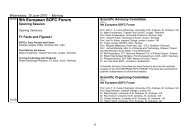European Fuel Cell Forum 2011
European Fuel Cell Forum 2011
European Fuel Cell Forum 2011
You also want an ePaper? Increase the reach of your titles
YUMPU automatically turns print PDFs into web optimized ePapers that Google loves.
�<br />
�<br />
<strong>European</strong> <strong>Fuel</strong> <strong>Cell</strong> <strong>Forum</strong> <strong>2011</strong> 28 June -1 July <strong>2011</strong>, Lucerne Switzerland<br />
A0702<br />
Towards stable catalyst supports<br />
Isotta Cerri, Tetsuo Nagami, Jon Davies and Brian Hayden<br />
Toyota Motor Europe<br />
Advanced Technology Division<br />
Hoge Wei 33<br />
1930 Zaventem<br />
Belgium<br />
Tel.: +32-2-7123189<br />
Fax: +32-2-7123399<br />
Isotta.cerri@toyota-europe.com<br />
Abstract<br />
Despite great progress in enhancing the performance of PEM fuel cells, durability remains<br />
one of the critical issues that need to be solved in order to successfully penetrate the<br />
automotive market.<br />
We have demonstrated that in automotive field tests the durability of the membraneelectrode-assembly<br />
(MEA) plays a major role in the overall lifetime of the stack. Transient<br />
conditions are responsible for MEA performance loss: power (or voltage) cycling increases<br />
the rate of electrocatalyst surface area loss; start-up/shut-down induces membrane<br />
degradation and carbon corrosion. Carbon under PEM fuel cell operating conditions is<br />
thermodynamically unstable and will be oxidized/corroded at potentials near the open<br />
circuit voltage of a fuel cell (about 1.0 V), with the oxidation rate increasing along with<br />
potential. It has been demonstrated that at start- up the lack of hydrogen at the anode is<br />
critical for carbon corrosion at the cathode. Carbon corrosion will finally result in Pt<br />
particles agglomeration and loss of performances.<br />
In the present study we have been focusing on the development of new catalyst support<br />
materials, as alternatives to conventional carbon supports to overcome the corrosion<br />
related issues. We have developed durable catalyst supports, using high throughput<br />
discovery and optimization, with enhanced electrochemical stability and improved<br />
electrical conductivity to sustain the electrochemical reactions.<br />
The present work will investigate the effect of different properties such as the chemical<br />
composition and crystallinity of the newly developed materials on the electrical conductivity<br />
and stability. In the design of the new support we paid special attention to the synergetic<br />
effect of the support on the catalyst, aiming at promoting higher catalyst activity and<br />
stability.<br />
PEMFC Components-Electrodes A07 - 2/10<br />
�<br />
�<br />
<strong>European</strong> <strong>Fuel</strong> <strong>Cell</strong> <strong>Forum</strong> <strong>2011</strong> 28 June -1 July <strong>2011</strong>, Lucerne Switzerland<br />
A0703<br />
Continuous preparation of highly active<br />
Pt/CNT catalysts<br />
Alicja Schlange, Antonio Rodolfo Dos Santos, Ulrich Kunz and Thomas Turek<br />
Institute of Chemical Process Engineering<br />
Clausthal University of Technology<br />
Leibnizstr.17<br />
D-38678 Clausthal-Zellerfeld, Germany<br />
Tel.: +49-5323-722187<br />
Fax: +49-5323-722182<br />
lezniak@icvt.tu-clausthal.de<br />
Abstract<br />
Direct methanol fuel cells (DMFs) are considered to be an attractive power source for<br />
portable application because of their simplicity in construction, high energy density and low<br />
emission of pollutants. For their widespread commercialization electrocatalysts with high<br />
metal loading and uniformly metal distribution are needed. To find a suitable method for<br />
catalyst preparation is still a challenge of fuel cell catalyst research, because it can<br />
strongly influence the catalyst morphology, particle size and moreover its catalytic activity.<br />
Commonly fuel cell electrocatalysts are prepared in batch processes using a heat mantle<br />
or an oil bath as a heat source. In this contribution we present the use of a continuously<br />
operated tubular reactor as a novel method for synthesis of carbon nanotube supported<br />
platinum catalysts. The as-prepared catalyst shows uniform dispersion of metal<br />
nanoparticles on the support material, an average crystallite size of 1.77 nm confirmed by<br />
XRD analysis and a Pt loading of 31 wt. %. Excellent electrocatalytic activity towards<br />
oxygen reduction reaction (ORR) of this catalyst was evaluated in a working DMFC<br />
environment. The reached maximum power density of 103 mW cm -2 was 60 % higher than<br />
for Pt/CNT catalyst prepared in a conventional batch process.<br />
PEMFC Components-Electrodes A07 - 3/10




